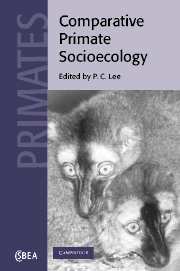Book contents
- Frontmatter
- Contents
- List of contributors
- Preface
- Part 1 Comparative methods
- 1 The comparative method: principles and illustrations from primate socioecology
- 2 Cladistics as a tool in comparative analysis
- 3 Phylogenetically independent comparisons and primate phylogeny
- Part 2 Comparative life history and biology
- Part 3 Comparative socioecology and social evolution
- Editor's conclusion: Socioecology and social evolution
- Index
1 - The comparative method: principles and illustrations from primate socioecology
Published online by Cambridge University Press: 24 August 2009
- Frontmatter
- Contents
- List of contributors
- Preface
- Part 1 Comparative methods
- 1 The comparative method: principles and illustrations from primate socioecology
- 2 Cladistics as a tool in comparative analysis
- 3 Phylogenetically independent comparisons and primate phylogeny
- Part 2 Comparative life history and biology
- Part 3 Comparative socioecology and social evolution
- Editor's conclusion: Socioecology and social evolution
- Index
Summary
Introduction
There are two major means of investigation across a wide range of sciences, both natural and social. These are the experimental method and the comparative method. In the so-called hard sciences – physics and chemistry – and also the ‘harder’ end of biology, investigation is more commonly by experimental manipulation. Other biological questions, notably those concerning evolutionary history and adaptation, are more or less inaccessible to experimentation, as are other aspects of the natural world, such as astronomical phemonena. Exploration of these areas and the development of explanations are undertaken largely by the comparative method, whereby common patterns and principles of variability are sought out, providing the basis for possible interpretation in terms of causes and effects. Similarly, in the social sciences, comparisons can be made across space and time of different societies, divisions or aspects of societies, with the aim of uncovering the origins and explanations of present features and past changes.
The comparative method has its origins in the realisation of the Enlightenment that the natural world can be understood and explained in terms of common principles and predictable variation. It involves testing the generality of suggested explanations for characteristics or phenomena, in contrast to ad hoc, one-off explanations that may merely reflect coincidence rather than causal connection. Predictions can be made from proposed general principles, and tested on further species, societies, stars or galaxies, and if borne out, they provide increased support for the validity of a principle.
The fundamentals of the comparative method were first expounded in the mid-nineteenth century by John Stuart Mill in his book A System of Logic (1872, 1967) in the chapter ‘Of four methods of experimental inquiry’.
- Type
- Chapter
- Information
- Comparative Primate Socioecology , pp. 5 - 22Publisher: Cambridge University PressPrint publication year: 1999
- 4
- Cited by



